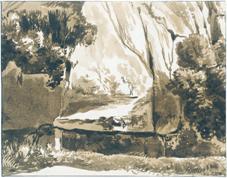Franz Kobell
dal 3/5/2005 al 24/7/2005
Segnalato da
3/5/2005
Franz Kobell
Pinakothek der Moderne, Munich
The artist stood between the tradition of the idyllic in landscape painting and a fully new concept of nature. His early drawings are ideal Arcadian landscapes in which the enthralling combination of jagged mountains, wild ravines with their impressive waterfalls and peaceful pastures are contrasted in an always-varying constellation. Around 1800 Kobell executed monochromatic brush sketches in which he captured rivers, cataracts and lush forests, discovering seemingly abstract structures in nature.

Draughtsman between idyll and realism
Franz Kobell (1749-1822) holds a place between two eras, as only few artists do. He took up the tradition of idyllic landscape painting which, having been initiated by Claude Lorrain, enjoyed a last flourish during the 18th century. At the same time, he originated a fully new conception of nature that would prove seminal for the 19th century.
Kobell’s early drawings boast idyllic Arcadian landscapes whose fascinating arrangement of rugged mountain ranges, wild ravines with impressive waterfalls and tranquil pastures are repeatedly varied in innovative constellations. Along with the most striking works of art from the holdings of the Staatliche Graphische Sammlung, a recent acquisition – a book with almost 200 drawings – impressively exemplifies these pastoral landscapes, in which Kobell’s landscapes give the impression of a definitive résumé of a 200-year-old tradition.
During the period around 1800, Kobell completed not only pen-and-ink drawings, but also monochromatic brush drawings, which have as their source the Isar river rapids and riverbank, as well as the tree thickets of the river meadows and countryside gardens on the outskirts of Munich. The artist came across therein virtually abstract structures in nature, which inspired him to create exhilarating compositions. Seemingly far beyond Kobell’s era, these drawings allude to 19th century realism, as well as 20th century non-representational painting. For Kobell not only observed nature’s details, as had many of his contemporaries, but developed compositions that can in fact be first understood by viewers whose judgment has been formed by art of the 20th century.
The Staatliche Graphische Sammlung München will contrast both of these aspects with roughly 140 works, several portfolios and albums from their own holdings as well as from private collections. The newly-acquired book will be made accessible in its entirety to visitors through a computer presentation.
Today Franz Kobell is less well-known than his brother Ferdinand (1740-1799) and his nephew Wilhelm von Kobell (1766-1855). This exhibition is an attempt at an art-historical uncovering of the artist Franz Kobell through a contrastive look at his tradition-defined and his forward-looking works.
A catalogue will be published (roughly 120 pages and 60 colour illustrations) with texts by Thomas Herbig and Andreas Strobl.
Exhibition curator: Andreas Strobl
Opening: March 4 at 19:00.
Pinakothek der Moderne
Kunstareal | Barer Str. 29 - Munich



